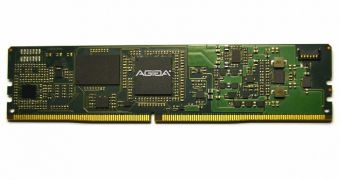As we noted on previous occasions, the main problem suffered by random access memory modules is that the memory processing and retention is dependent on constant power. Cut the power and everything is lost.
It can become a real pain in the neck when you work for a long while on a project and forget to save, only for a power failure to totally destroy all your progress.
It can be even worse for servers and data centers, no matter the type. They work with many terabytes of RAM at once, and a power cut can wreak havoc.
That's why many memory makers have been trying to figure out how to extend the data retention of solid state memory to random access memory.
Which is to say, they've been trying to see how one might make RAM always remember data like solid state drives do, since the latter don't get amnesia when they get turned off for whatever reason.
In the end, the solution came in the form of the NVDIMM, or nonvolatile DIMM memory modules (DIMM is the standard module type of desktop PCs).
In fact, with the DDR4 standard getting ready to step in after years of sole DDR3 availability, many DDR4 modules seem to be going the NVDIMM route.
Just this week we saw the NVDIMM from SMART Modular, and now AgigA Tech, a subsidiary of Cypress Semiconductor Corp., is releasing something similar.
Called AGIGARAM DDR4 NVDIMM, it is exactly what the name says. The RAM has a capacity of 8 GB or 16 GB, maybe even 32 GB. AgigA didn't really say it in the press release.
It did mention the 50% performance increase over DDR3 (the clock is of 2,400 MHz), as well as a 20% reduction in operating voltage (DDR3 comes in 1.5V or 1.35V in low voltage mode, but DDR4 can make do with 1.2V just fine).
Add to that some extra power saving features for DDR4 RAM and you have 40% better efficiency compared to DDR3, on average.
Still, the important part here is that data isn't lost or corrupted upon power failures, so NVDIMMs are quite useful in mission-critical applications. It will be interesting to see how many companies and professionals adopt it once motherboards with DDR4 support come in (mostly X99-based platforms intended for Intel Haswell-E CPUs). It is possible that some will debut at IFA 2014, in September, but we'll have to wait and see.

 14 DAY TRIAL //
14 DAY TRIAL //